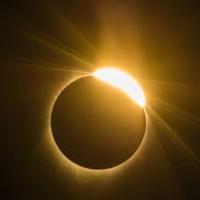
 |

Understanding Solar Eclipses: Nature's Spectacular Show
Solar eclipses, among the most captivating celestial events, continue to mesmerize and intrigue both seasoned astronomers and curious spectators alike. These occurrences, where the Moon passes between the Sun and Earth, casting its shadow on our planet, provide a rare glimpse into the intricacies of our solar system. As we prepare for the upcoming solar eclipse on April 8, 2024, let's delve into the science and wonder behind these remarkable phenomena.
What is a Solar Eclipse?

A solar eclipse transpires when the Moon's orbit aligns precisely with the Earth and Sun, causing the Moon to obstruct the Sun's light partially or entirely. This alignment results in three distinct types of solar eclipses: total, partial, and annular.
Total Solar Eclipse: During a total solar eclipse, the Moon completely covers the Sun, casting a shadow on Earth and momentarily obscuring daylight.
Partial Solar Eclipse: In a partial solar eclipse, only a portion of the Sun is obscured by the Moon, creating a mesmerizing celestial spectacle where a fraction of the solar disc remains visible.
Annular Solar Eclipse: An annular solar eclipse occurs when the Moon is farthest from Earth in its elliptical orbit, appearing smaller in the sky. As a consequence, the Sun forms a bright ring, or annulus, around the Moon during the eclipse's peak.
The Mechanics Behind Solar Eclipses
Solar eclipses transpire due to the impeccable alignment of the Sun, Moon, and Earth during specific phases of the Moon's orbit. The Moon's orbit is inclined by approximately 5 degrees relative to Earth's orbit around the Sun. However, eclipses transpire only when the Moon crosses Earth's orbital plane at the precise moment of the New Moon phase, known as the syzygy.
Safety Precautions During Solar Eclipses
While witnessing a solar eclipse can be a breathtaking experience, it's crucial to observe safety precautions to protect your eyes from potential damage. Staring directly at the Sun, even during a partial eclipse, can cause severe eye injury. It's imperative to utilize certified solar viewing glasses or specialized solar filters to safely observe the eclipse without risking eye damage.
The April 8, 2024 Solar Eclipse
On April 8, 2024, skywatchers across North America will have the opportunity to witness a total solar eclipse, traversing a path spanning from Mexico to Canada. This celestial event promises to be an unforgettable experience, offering spectators the chance to marvel at the wonders of the cosmos and the delicate dance of celestial bodies.
Conclusion
Solar eclipses serve as a poignant reminder of the cosmic ballet unfolding in the vast expanse of space. As we eagerly anticipate the upcoming solar eclipse on April 8, 2024, let's embrace the opportunity to connect with the universe and marvel at the beauty and majesty of our solar system's celestial phenomena. Whether observing from afar or experiencing it firsthand, the solar eclipse is sure to leave an indelible mark on all who witness its splendor.